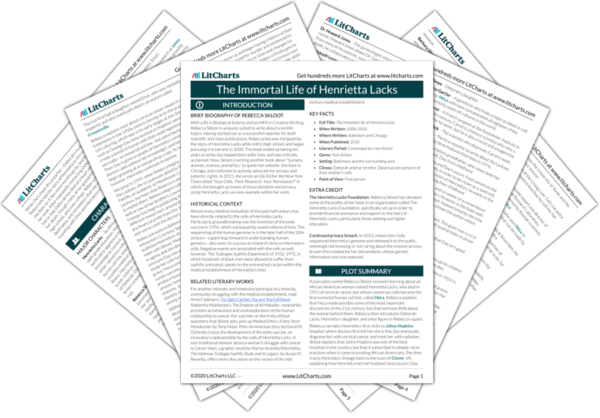Summary
Analysis
It is January 29, 1951, and David Lacks, Henrietta’s husband, is waiting with his three children outside Johns Hopkins Hospital. A few minutes earlier, Henrietta had entered the hospital, gone past the “colored” bathroom, into the main entrance of Hopkins, past a lucky statue of Jesus, and then continued into the waiting room of the gynecology clinic, where she tells the receptionist that she has “a knot on my womb.”
Skloot begins the main part of her narrative in a gripping fashion. This is her journalistic technique for telling a story that largely has to do with complicated scientific advances—she never lets her readers forget about the human beings behind those advances, and the lives they led.
Themes
We flash back a year, to when Henrietta tells her cousins and close friends, Margaret and Sadie, that she has “a knot inside me” that hurts terribly when she has intercourse with her husband. At first, she believes that it has to do with having given birth to Deborah a few weeks earlier, or to the STIs that David Lacks has given her in the past by being unfaithful. However she refuses to get it checked. Later, Sadie would speculate that Henrietta didn’t want to have surgery that would make her infertile.
We are already beginning to learn about a bit more about Henrietta’s personality now that she is introduced as a character rather than just a historical or scientific figure. She is intuitive, but also very stubborn.
Themes
About a week later, the twenty-nine-year-old Henrietta is pregnant yet again with Joe, her fifth child. Sadie and Margaret believe that the pain had to do with the baby, but Henrietta disagrees. About four and a half months after Joe is born, Henrietta finds blood in her underwear. Henrietta probes her own cervix with a finger, eventually finding “a hard lump” like a marble. She tells her husband that he needs to take her to the doctor because she is “bleedin and it ain’t my time.” The local doctor believes the lump to be a sore from syphilis, but when it tests negative for the STI, he tells her to go to the Johns Hopkins gynecology clinic.
Skloot gradually builds a sense of foreboding as Henrietta’s cancer continues to progress untreated. As the narrative goes forward, readers will better understand the reasons for the deep fear that Henrietta and her family have for the medical establishment, which fuels her reluctance to seek a diagnosis for the lump on her cervix.
Themes
At this time, Hopkins was “one of the top hospitals in the country.” Built as a charity hospital in 1889, it services large numbers of poor, black patients. In fact, the reason that Henrietta visits there is because “it was the only hospital for miles that treated black patients” due to the segregation of Jim Crow laws.
Although much of the book will be critical of Johns Hopkins, here Skloot reminds us that Hopkins’ policy towards black patients was in fact fairly progressive for its time.
Themes
Get the entire Henrietta Lacks LitChart as a printable PDF.

After Henrietta waits, a nurse leads her to a “colored-only” exam room. Howard Jones, an older Southern doctor, treats her. He reads her chart, finding many conditions that Henrietta has left untreated throughout the years. The chart also details that Henrietta has an epileptic daughter. Two months ago, after delivering Joe, Henrietta had significant blood in her urine, and the cells around her cervix seemed abnormal. Despite a doctor recommending further tests, Henrietta canceled her appointment. She also had recently contracted gonorrhea, but hadn’t been tested.
Skloot takes care to include the detail about the “colored-only exam room” in her narrative in order to make readers understand the deep inequality and racism that existed within the medical community at this time. We also begin to learn about Henrietta’s various ailments, most of which have gone entirely untreated. During this time, black women simply did not get the medical care that they needed—afact that will cost Henrietta her life.
Themes
The author explains that it is unsurprising that Henrietta didn’t return for follow-ups; “like most black patients,” she only went to Hopkins when it was the only option.
Henrietta tells Dr. Jones about the pain and the blood, and adds that she has found a lump in her cervix. He examines her and finds the lump. While he’s seen many cancers, this one is unique: it is “shiny and purple,” and prone to bleeding. Jones takes a sample and sends it to a lab for a diagnosis. He later writes how alarming it is that Henrietta was recently in the hospital for the birth of her child, but that she has returned “with a full-fledged tumor” three months later. Either her doctors had missed the growth, “or it had grown at a terrifying rate.”
Already we begin to learn that Henrietta’s cancer cells are special in some way—they even look visually different than other tumors. The speed of the tumor’s growth further confirms the cells’ uniqueness. At the same time, the narrative is concerned not just with the medical oddity of the tumor, but about the effect it will have on Henrietta, continuing the pattern of balancing scientific fact with personal narrative.
Themes












